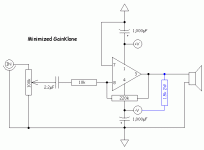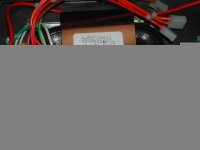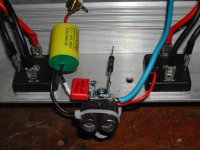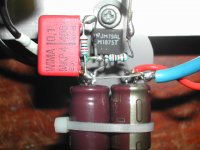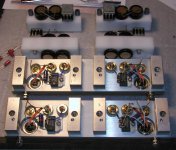I agree with Peter that the gc sounds amazing.After a few weeks now of breaking in I did another A/B with the Aleph 5s and at reasonable output levels the gc just has more detail ,soundstaging and precision with great timing and dynamics.Not that the Aleph is not musical-it is a very musical amp-but when you A/B with the gc you realize that the Aleph picture is more diffuse.The bass is fuller but it is more quantity not quality.The gc has less quantity per se but it is surprisingly tight fast and tuneful in the bass and goes quite low when the notes are there.
I am still wondering whether it is worth the considerable more effort and the money to try and build a "better" discrete amp (Aleph X?) . As NP said the main culprits in distortion are the active components and spending a lot of effort and money on resistors and caps is only going to get you so far.I wonder if the new power op amps are the magic bullet?
Don't get me wrong , the Alephs I made were a labour of love and I kind of hate it that the gc sounds better but I can't ignore what my ears are telling me.
As for power how about the OPA 549 with 8A (mentioned by Hamish) or even the OPA 512 with 15A!
Peter, I know this is a difficult question but what in your view contributed to the better power supply?
I am still wondering whether it is worth the considerable more effort and the money to try and build a "better" discrete amp (Aleph X?) . As NP said the main culprits in distortion are the active components and spending a lot of effort and money on resistors and caps is only going to get you so far.I wonder if the new power op amps are the magic bullet?
Don't get me wrong , the Alephs I made were a labour of love and I kind of hate it that the gc sounds better but I can't ignore what my ears are telling me.
As for power how about the OPA 549 with 8A (mentioned by Hamish) or even the OPA 512 with 15A!
Peter, I know this is a difficult question but what in your view contributed to the better power supply?
protos said:
...........
Don't get me wrong , the Alephs I made were a labour of love and I kind of hate it that the gc sounds better but I can't ignore what my ears are telling me.
...........
Funny, the JHL class A I made still sounds better than the GC 😉
argo
Hi Argo,
I agree totally. My JLH 10W Class A amp also sounds better to my ears than my GainClone.
😉
gr,
Thijs
I agree totally. My JLH 10W Class A amp also sounds better to my ears than my GainClone.
😉
gr,
Thijs
Don't be so fast in your judgement what sounds better or what is best. I've built 2 gainclones and one sounds substantially better than the other. It all depends on small construction details and parts selection.
As to the PS, I think that rectifying diodes and maybe the umbilical cord made the difference. I also used two different transformer types. I still have to investigate it.
I agree with Herb Reichert when he talks about amp design:
"You see, I believe most deeply that the real magic ingredient in any amp design is the wu of the designer. The wu flows from the designer's hands during construction and raises the effort above the common and imperfect."😉
As to the PS, I think that rectifying diodes and maybe the umbilical cord made the difference. I also used two different transformer types. I still have to investigate it.
I agree with Herb Reichert when he talks about amp design:
"You see, I believe most deeply that the real magic ingredient in any amp design is the wu of the designer. The wu flows from the designer's hands during construction and raises the effort above the common and imperfect."😉
Since I got few emails regarding the schematic, here it is again. I didn't like the blue 1K5 resistor and I find that circuit sounds much better without it. My coupling cap is 4.7/50 BG N. PS is using 400VA double 22V secondaries and the rectifiers are MUR Motorola diodes. The umbilical cord is 8 strands, run side by side, of silver plated copper stranded wire in teflon insulation. There are two bridges, one for positive, one for negative rail, used for both channels. So ea. channel is powered by 4 cables, with separate grounds, connected together at the - speaker terminal.
No capacitors in the PS unit (even small ones). At the amp, I'm using 2 x 1000u/50V BG electrolytics per channel. Also the pot is log. with 50k resistance (both halfs of 100k in parallel).
I'm using 3 spikes under the chassis, and they improve the sound evidently.
No capacitors in the PS unit (even small ones). At the amp, I'm using 2 x 1000u/50V BG electrolytics per channel. Also the pot is log. with 50k resistance (both halfs of 100k in parallel).
I'm using 3 spikes under the chassis, and they improve the sound evidently.
Attachments
Peter,
The best of the rest I’m still to hear.
But are we speaking minor sound quality variances or sound characters of different leagues?
BTW the GC I built outperformes IMHO the Mini-A (Grey's scaled down version of Alephs) I built (but I did'nt put any wu into it either)
argo
The best of the rest I’m still to hear.
But are we speaking minor sound quality variances or sound characters of different leagues?
BTW the GC I built outperformes IMHO the Mini-A (Grey's scaled down version of Alephs) I built (but I did'nt put any wu into it either)
argo
You made my day again Peter ;-)
I always get happy when people like their clones, I don't exactly know why...
I wonder what will happen with your amp if you try good stepped attenuators!!! (or even better: volume transformers like sowther!)
Do you always use LM3875TF or also the T version?
How does your amp sound when played louder ? Does it loose control easily? (focus, bass)
BTW: In the amp you mentioned do you have a single supply for both channels ??? You can interpret the text in two ways!
I always get happy when people like their clones, I don't exactly know why...
I wonder what will happen with your amp if you try good stepped attenuators!!! (or even better: volume transformers like sowther!)
Do you always use LM3875TF or also the T version?
How does your amp sound when played louder ? Does it loose control easily? (focus, bass)
BTW: In the amp you mentioned do you have a single supply for both channels ??? You can interpret the text in two ways!
I'm always using non insulated version with berryliun oxide washer. I think that heat transfer is better this way. Yesterday the amp got pretty warm during the session (I would say 40-45 deg C). Even when played loud it didn't loose control, but the speakers, based on Dynaudio drivers, were not very efficient (87 dBor so). The amp has single supply for both channels (1 toroid, 2 bridges). Toroid is 400VA though.
When I tried the amp with 1k5 resistor from output to - rail it was day and night. It lost all the magic when resistor was connected. Regarding, comparison betwee the two gainclones, it seems that they have similar character, but again the other one is producing more magic. In other words it is more open and musical with subtal nuances portrayed in somewhat better way. And there is absoutely nothing to complain about the bass. BTW, the guy who keeps my amp used to be a Cello player.😉
When I tried the amp with 1k5 resistor from output to - rail it was day and night. It lost all the magic when resistor was connected. Regarding, comparison betwee the two gainclones, it seems that they have similar character, but again the other one is producing more magic. In other words it is more open and musical with subtal nuances portrayed in somewhat better way. And there is absoutely nothing to complain about the bass. BTW, the guy who keeps my amp used to be a Cello player.😉
Hi Peter,
Sorry to take up your time on this, but in post #474 you mentioned two PS's you had tried (I know for two different versions of the GC), 24V and 18V, and I believed that you indicated the 18V secondary was preferred.
Before I order the necessary transformer, could you clarify this please, especially as you now refer to 22V?
Regards, 🙂
Sorry to take up your time on this, but in post #474 you mentioned two PS's you had tried (I know for two different versions of the GC), 24V and 18V, and I believed that you indicated the 18V secondary was preferred.
Before I order the necessary transformer, could you clarify this please, especially as you now refer to 22V?
Regards, 🙂
Just finished
12:09am Indonesian Time.
I finished building my GC 2 hours ago and have been listening to it till now, even as I type this message. First impression, (when music is starting), it was surprisingly good for such a simple circuit. I thought it was sliiiightly less detailed than my commercial Yamaha BX-1 Class A amp. I hope it will improve as it is breaking in. I am using Mr. Thorsten Circuit with regular resistor and capacitor with the exception of the AuriCaps for the input coupling (WIMA MKP4 for the 100nf). I will try to attach some pics later.
12:09am Indonesian Time.
I finished building my GC 2 hours ago and have been listening to it till now, even as I type this message. First impression, (when music is starting), it was surprisingly good for such a simple circuit. I thought it was sliiiightly less detailed than my commercial Yamaha BX-1 Class A amp. I hope it will improve as it is breaking in. I am using Mr. Thorsten Circuit with regular resistor and capacitor with the exception of the AuriCaps for the input coupling (WIMA MKP4 for the 100nf). I will try to attach some pics later.
Attachments
Bobken said:Hi Peter,
Sorry to take up your time on this, but in post #474 you mentioned two PS's you had tried (I know for two different versions of the GC), 24V and 18V, and I believed that you indicated the 18V secondary was preferred.
Before I order the necessary transformer, could you clarify this please, especially as you now refer to 22V?
Regards, 🙂
Some people claim that 18V sounds better with more diffficult loads. My original supply was 2x 22V secondaries on 400VA Plitron transformer. Because of regulation the actual voltage was more like 2 x 24V.
My second supply is using two EI core, split bobbin, 200VA transformers; one transformer per rail. Both channels are powered by a single PS.
I used different rectifiers in ea. supply, so it's really hard to comment on differencies, but to my surprise the higher voltage supply sounded better.
If you need more detailed comparison, you just have to wait, because I'm waiting for more toroids from Plitron and then I'll check all options. So for now my advice is, if you need more power don't be afraid to use higher voltage supply.
Hi Peter,
Thanks a lot for the clarification here, it is much appreciated.🙂
Regards,
Edit: A thought which as a Moderator you will probably also know the answer to, is there any likelihood of any of these posts being deleted in due course for say space-saving reasons on the Forum?
No hurry for any reply, but I would hate to lose some of these valuable comments, in case at some time in the future they would be handy to look back at.
Many thanks
Thanks a lot for the clarification here, it is much appreciated.🙂
Regards,
Edit: A thought which as a Moderator you will probably also know the answer to, is there any likelihood of any of these posts being deleted in due course for say space-saving reasons on the Forum?
No hurry for any reply, but I would hate to lose some of these valuable comments, in case at some time in the future they would be handy to look back at.
Many thanks
I'm not aware of any possibility of some posts to be removed for space saving. I'm using a lot of bookmarks myself, and when site was down I realised what a loss it would be if I was to loose them.
ok dokie - ive given up with the transformer adding wires (i dont see the point) - so how many turns would i need to remove?
my amplifier is very close to being finnished - i need to sort out the transformer (its currently a 300va 30v transformer - needs to be about 25v)
and i need to find some 2.2uf film capacitors and some high Amperage wire (sounds like a trip to maplins)....
my amplifier is very close to being finnished - i need to sort out the transformer (its currently a 300va 30v transformer - needs to be about 25v)
and i need to find some 2.2uf film capacitors and some high Amperage wire (sounds like a trip to maplins)....
I did that on my toroid, to get 18V out of 24V. I had to remove around 4 to 5 feet of wire. When you do it, you can take readings in a meantime, so you can't go wrong.
When you remove the wire, you don't have to go to maplins, because you already have some high Amperage wire.😉
When you remove the wire, you don't have to go to maplins, because you already have some high Amperage wire.😉
Peter Daniel said:I did that on my toroid, to get 18V out of 24V. I had to remove around 4 to 5 feet of wire. When you do it, you can take readings in a meantime, so you can't go wrong.
When you remove the wire, you don't have to go to maplins, because you already have some high Amperage wire.😉
lol suppose so.....
only problem is it dosn't turn into a capacitor

- Status
- Not open for further replies.
- Home
- Amplifiers
- Chip Amps
- This is not just another gainclone
